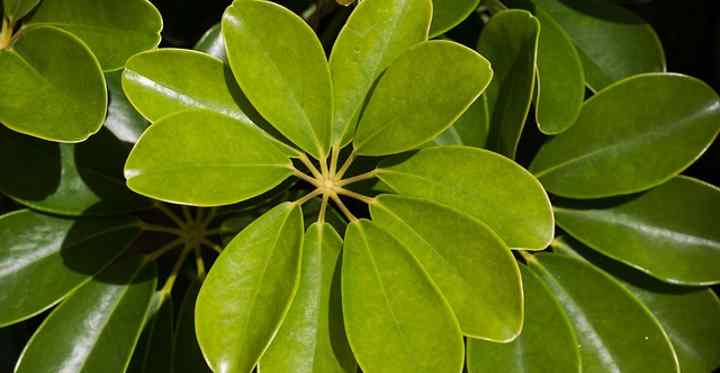The umbrella plant (also known as Schefflera arboricola or Heptapleurum arboricola) is a popular houseplant that requires little effort to care for. Dwarf umbrella tree, parasol plant, octopus tree, and dwarf Schefflera are some of the other popular names for this tall houseplant. The umbrella plant, which thrives in pots, creates a towering indoor tree-like plant. The Schefflera plant is the top trendy houseplant for a variety of reasons, including its large leaves and bushy foliage.
How to care for dwarf umbrella plant: In bright filtered light, a well-draining potting mix, and average humidity, the Schefflera arboricola grows like a tiny indoor tree. When the top layer of soil dries, water the tropical umbrella plant, mist it occasionally, and feed it monthly throughout the growing season. Temperatures between 60°F and 75°F (15°C – 24°C) are ideal for Schefflera growth. The flowering plant Schefflera arboricola is indigenous to Taiwan and belongs to the Schefflera genus. In fact,Schefflera’s dwarf plant seldom blooms indoors.
The big Schefflera actinophylla, often known as the Australia umbrella tree, is closely related to the umbrella plant, which is a dwarf form of the Schefflera tree. The dwarf umbrella tree is a popular houseplant that grows to be 4 to 8 feet (1.2 to 2.4 meters) tall in just a few years. This tree has palmate leaves, which are umbrella plant leaves with 7–9 leaflets that emerge from a single point. Several cultivars feature variegated leaves with green and creamy-white or yellow designs, and the majority of its foliage is green.
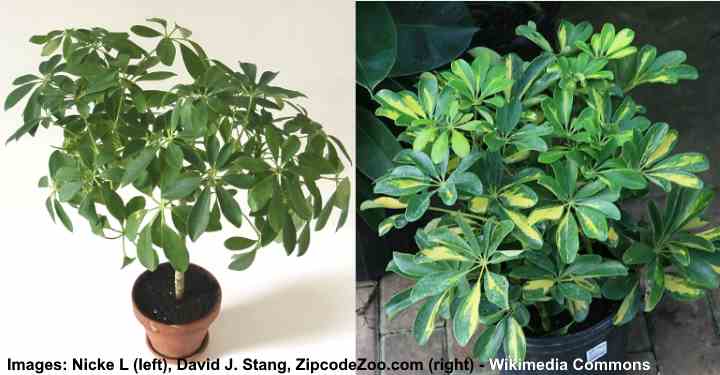
Several cultivars of the Schefflera arboricola (dwarf umbrella tree) exist, and some have variegated leaves. The leaves have the appearance of an umbrella because the clusters of leaflets grow in a circular pattern at the end of stems. The care of the umbrella plant (Schefflera arboricola) will be discussed in this article. When cultivating this plant indoors, you’ll also learn how to cope with a few challenges that might occur.
How to Care for Umbrella Plant (Schefflera arboricola)
When it comes to care, dwarf umbrella trees are nonchalant. Most indoor environments are suitable for growing houseplants. You may grow umbrella plants in rooms or workplaces with medium light and watering twice a month. Now, let’s look at how to take care of a Schefflera plant in greater detail.
Light Requirements for Growing Dwarf Umbrella Tree Indoors
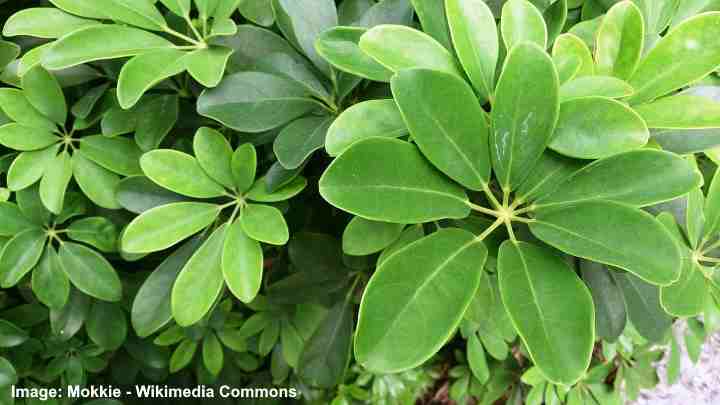
Place umbrella plants in bright light but protect them from direct sunlight to encourage fast growth of your schefflera plant. Plants, like trees, prefer plenty of light to grow straight. Since your umbrella tree-like plant has a thick, healthy look, light also helps the leaves to be numerous and bushy.
Variegated dwarf umbrella tree cultivars need good indirect sunlight as well. Make certain that there is adequate lighting if you have the Schefflera ‘Gold Capella,’ ‘Green Gold,’ or ‘Trinette.’ The exquisite bright foliage loses its brilliance and vibrancy as a result of a lack of light.
Even though dwarf Schefflera plants can survive in low light, their development will be sluggish. A tree-like plant with bent or twisted stems is another possibility. Leggy growth with sparse foliage and a scruffy appearance can be caused by growing in poorly-lit rooms, bathrooms, or complete shade.
The Best Potting Soil for Umbrella Plants

Schefflera arboricola needs a potting mix with excellent drainage and a well-draining soil. Two parts peat moss and one part perlite should be present in the ideal growing medium. The potting soil retains some moisture without becoming soggy or wet, which is a crucial water retention requirement for umbrella plants.
Combining equal proportions of humus, garden soil, and perlite or coarse sand may also be used to create an appropriate potting mix. Organic materials stay moist while using perlite, which improves drainage. It is important to use a pot with drainage holes to prevent your soil from becoming waterlogged.
Umbrella Plant Water Requirements

Water your dwarf umbrella tree when the top soil is dry, and it will thrive properly at home. During the summer, water your umbrella plant every week or so, and less often during the winter. Fill the soil around umbrella plants with water and let it run out thoroughly.
Moisture can reach the roots when the soil is saturated. As long as you only water when the top portion of soil has totally dried, this sort of hydration allows the plant to flourish in any circumstance. To prevent the soil from sitting in water, always empty any water from a drip tray.
Watering your houseplants on a schedule is a common mistake. Water absorption rates differ depending on the sort of plant. Umbrella plants may also be watered less often in warm weather and with fluctuations in humidity. Watering the plant less frequently in the winter than in the summer is required.
Temperature for Growing Schefflera Arboricola
Between 60°F and 75°F (15°C and 24°C), dwarf umbrella plants thrive. As a result, in typical room temperatures, tropical houseplants will thrive. In cooler temperatures, umbrella plants with dark green leaves can better cope. The variegated cultivars need to be grown in warmer temperatures.
The cold gets to dwarf umbrella trees. Plants of Schefflera arboricola may be kept alive in USDA zones 10 and 11 as long as they are placed in partial shade. If you reside in temperate regions, you may also bring umbrella plants outside during the summer. However, if the temperature drops below 55°F (13°C), the leaves might begin to fall, so you must be cautious.
What is the Right Humidity for Indoor Umbrella Plants?
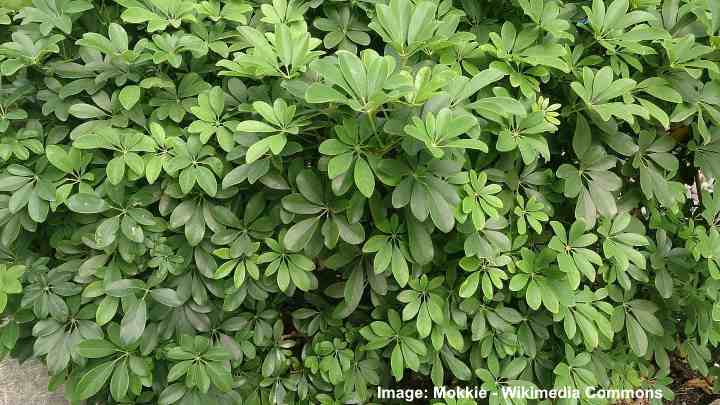
In typical indoor humidity with periodic misting, Schefflera arboricola (or Heptapleurum arboricola) trees flourish. They enjoy a little misting from time to time, despite their tolerance of normal indoor humidity. In addition to increasing air moisture, you could use a room humidifier or a pebble water tray. Wipe the leaves of umbrella plants with a damp cloth to ensure them stay moist and looking beautiful.
Pests such as spider mites and scale are common on dwarf umbrella plants while they are growing indoors. These sap-sucking insects may be kept at bay by keeping humidity levels above 50%. In the winter, when heat tends to dry out the air, getting humidity levels right may be difficult. You need to water less and refrain from fertilizing throughout the winter, when development slows to a halt. Regularly watering the plants can help keep them looking nice and bright.
How to Fertilize Umbrella Plants

During the growing season, fertilize your Schefflera every two to four weeks. In the spring and summer, these umbrella plants can cover a lot of ground fast. Use a half-strength diluted regular houseplant fertilizer. To promote quick development, apply the fertilizer every two weeks; alternatively, apply it every four weeks.
In the autumn and winter, you should stop feeding the plant. Fertilization might cause root damage and even kill your plant since growth is dormant. When the tall indoor plant has achieved its desired height, there is another reason to wait until feeding.
Umbrella Plant Growth Rate
When grown in the correct circumstances, dwarf umbrella trees sprout quickly. The growth rate of a plant is helped by bright light, regular watering, and feeding every few weeks. Umbrella plants may grow three feet (0.9 meters) each year during the growing season. It’s incredible how quickly this plant grows in a single season.
Of course, in the winter, growth slows down. You should check the growing conditions if there seems to be little growth in the spring and summer. The plant might be rootbound and require repotting if it is growing at a leisurely pace. The tree-like plant, under ideal circumstances, may reach a height of 6 feet (1.8 meters) and a width of 2.5 feet (75 centimeter) indoors.
Schefflera Arboricola Flowers

At home, the umbrella plant seldom blooms, producing tiny white spike clusters in clusters. These dwarf trees are mostly recognized for their spectacular leaves and seldom bloom indoors. As seen in the image above, the dwarf Schefflera plant produces small white flowers. The dwarf Schefflera blooms produce clusters with an imposing appearance.
Umbrella Plant Leaves
Since it seldom blooms indoors, people grow a dwarf Schefflera plant for its spectacular leaves. Yellow and green or white and green variegated cultivars are among the best umbrella plants for indoors. Fascinating leaf patterns may produce a stunning vertical emphasis in a room or workplace for certain plant species.
Pruning an Umbrella Plant
It is critical to maintain a Schefflera plant in a reasonable size indoors. To improve the plant’s appearance, you should also trim leggy stems and dead leaves. New stems and leaves grow back quickly as a result of their rapid development. Just pinch back leggy stems above the node and you’ll be done.
Regular trimming throughout the growing season also helps encourage bushy, compact development. To make the plant grow more like a bushy indoor shrub rather than a big tree, you should trim back unsightly growth. You may reduce the size of the main branch to regulate the plant’s growth if it becomes too big for your space.
How to Propagate Schefflera
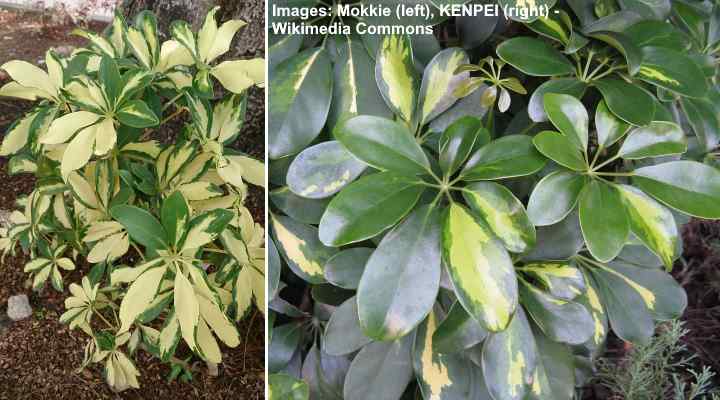
Cuttings from the Schefflera plant are simple to grow. The most effective method to grow dwarf umbrella trees is through stem cuttings in these images. A stem should be 4″ to 6″ (10 – 15 cm) long when you cut it just below a node. Remove the lowest leaves from the cutting and apply a rooting hormone to the end node. Leave 3-4 leaves on top.
Put stem cuttings in a jar of water to root them in a warm, humid environment. Roots should start to develop after a few weeks if the jar is kept in a warm, bright environment. Transfer to a pot filled with well-moistening potting soil.
Repotting Umbrella Plants Indoors
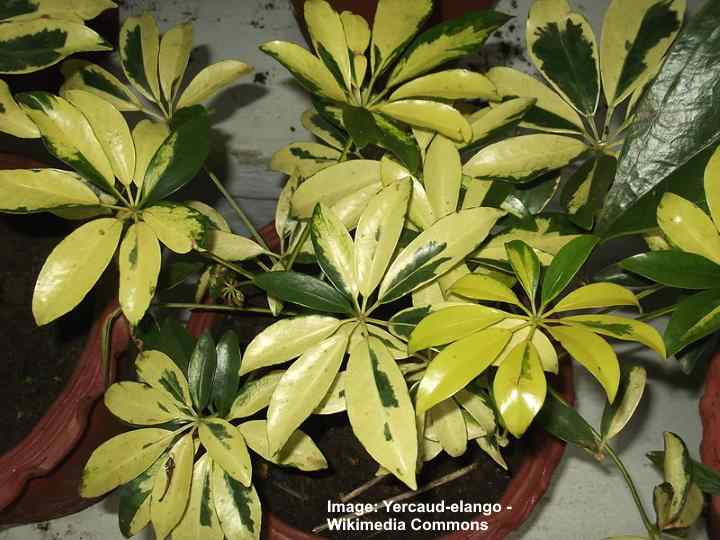
To encourage healthy growth, repot your Schefflera arboricola plant every two or three years. Repotting umbrella plants prevents the plant from becoming rootbound and encourages growth. Roots protruding from drainage holes or sluggish development are common symptoms that a dwarf umbrella tree needs replanting.
When selecting a replacement for a dwarf umbrella tree, choose a heavy terracotta pot. Because of the extra weight, the plant’s stability has improved. One or two sizes larger than the current container should be selected. The following are the steps for repotting an umbrella plant at home:
- Remove the dwarf umbrella tree from the pot with care.
- Remove all excess dirt and separate the tangled roots.
- Root rot symptoms, such as brownish, mushy roots, should be checked.
- Fill the new potting mixture halfway with the necessary amount.
- In its new pot, put the umbrella shrub at the same height.
- The rest of the fresh potting soil should fill in the remaining area.
- Before watering again, thoroughly water the plant and wait until the soil has mostly dried.
- Wait six to eight weeks after repotting before fertilizing because the new potting soil is rich in nutrients.
Pests and Diseases Affecting Dwarf Umbrella Tree Growth

Spider mites, scale, and aphids are the most common offenders on dwarf umbrella trees, and use neem oil solution to quickly eliminate them. A Schefflera plant can wilt and die quickly if it is infested by tiny insects. The first indications of indoor plant pests should be detected and removed as soon as possible.
Spider mites and scale insects may be drawn to a lack of humidity. Therefore, maintain medium to high humidity in your dwarf umbrella trees as a precaution. If insects get into your plant, use a neem oil solution or insecticidal soap to eliminate them immediately.
Are Umbrella Tree Plants Toxic?
Cats and dogs should not be around plants in the genus Schefflera. Schefflera plants contain harmful chemicals known as calcium oxalate crystals, according to the American Society for the Prevention of Cruelty to Animals (ASPCA). If pets eat portions of umbrella plants, these toxins may cause oral discomfort, excessive drooling, and vomiting.
FAQs About Growing Umbrella Plant (Schefflera arboricola) Indoors

Why is my umbrella plant dropping leaves?
If you are watering the Schefflera plant too much or insufficiently, the leaves may begin to fall. Only water when the top 1″ to 2″ (2.5 – 5 cm) of soil is dry, because it will be moist. Temperature extremes, bad light, or moving the plant around too much are additional reasons for dropping leaves.
How can I stop my dwarf umbrella tree from falling over?
Umbrella plants turn into towering tree-like plants inside. Because it is a multi-stemmed shrub, they may occasionally become top-heavy or topple over. You may boost stability by growing the little tree in a terracotta pot. By loosely tying the stems together, you can also prevent the plant from keeling over.
Why are umbrella plant leaves turning yellow?
Schefflera, for example, has older leaves that fall away naturally before turning yellow. It could, nonetheless, signify a distinct problem if many leaves on the crown become yellow simultaneously. The most common cause of yellowing leaves is over-watering. Yet, high heat, temperature changes, or undernurturing may cause leaves to yellow.
Why is my umbrella plant got sticky leaves?
Sticky substances on the leaves of your Schefflera are usually a sign of a pest infestation. The sap of the plant may be drawn by aphids, mealybugs, and scale insects, which is then excreted in a sticky honeydew form. It’s vital to treat householdplant bugs right away. If your plant dies, insects may infest other plants in your home.
Why has my umbrella plant stopped growing?
In the winter, Schefflera plant growth comes to a halt, and there isn’t much chance of it regrowing. It might be due to feeding problems if growth slows down and leaves become pale at different times of the year. From spring through the end of summer, apply a diluted houseplant fertilizer once a month.
How to avoid crooked or bent stems when growing dwarf umbrella trees
If there isn’t enough light, umbrella plant stems may grow crooked. Stems tend to grow toward the sun. The stems will bend and lean towards the light if the light comes from just one source, such as a window in a dimly-lit room. Place your Schefflera plant in bright light and rotate it occasionally to ensure that the light is evenly distributed to prevent crooked stems.
